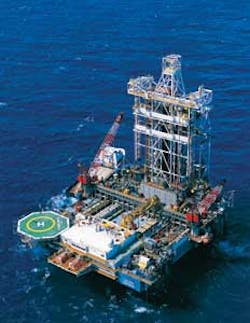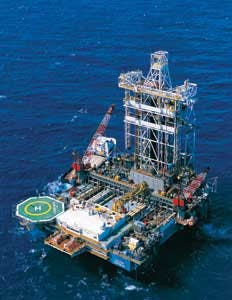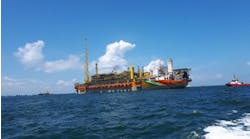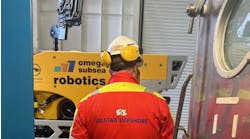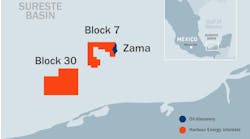Dick Ghiselin
Contributing Editor
How hot is hot? How high is high? These apparent riddles are the kinds of questions oil and gas companies and their service partners have been asking themselves for several years. The answers have been somewhat ambiguous. Ask any 10 petroleum industry people and you will get as many answers. However, high-temperature/high-pressure (HP/HT) wells are becoming far more prevalent as the industry moves to deeper frontiers and less conventional recovery techniques, so the questions are no longer academic. For as many years as the above questions have been asked, various people have come up with solutions. But often, the solutions were customized for a particular area or even a particular well. It was rare that a universal HP/HT solution was introduced. As a result, distinct gaps exist in the technology. Research and engineering are needed to fill these gaps, but the technological challenges are immense. What is needed is an organized approach to identify and prioritize industry needs and quantify the market opportunities to satisfy them.
A systematic approach
In order to evaluate potential solutions one must first define the market. Different groups have set arbitrary limits, but they lack industry-wide acceptance and they vary widely. A popular definition of HP/HT environments has evolved since the early 1990s.
The rationale for declaring 10,000 psi (689 bar) as the pressure threshold is related to the behavior of standard elastomeric seals at 300°F (149°C). Companies exposing their downhole equipment to temperatures in this range find it prudent to replace o-rings on make-up joints before running the tools to those temperatures again. Even though under moderate temperatures the seals can withstand up to 15,000 psi (1,034 bar) to meet the standardized definition of the HP/HT market, the temperature and pressure ratings should be considered together when defining thresholds.
Of greater interest, and the subject of some discussion, are the temperature and pressure thresholds that define the intermediate range, the so-called ultra-HP/HT market. The rationale behind defining the upper limits of this market is the practical upper operating limit of existing electronics technology. Operating electronics beyond this level will require considerable technical development. Options include research to possibly develop new electronics-based materials with higher temperature tolerances, or employ some kind of internal heat sink to cool the circuitry and electronic components.
While successful HP/HT operations have been conducted using the time factor, these should not be considered when defining the markets. Some services have been able to use the time-at-temperature approach to qualify their equipment for HP/HT use. They reason that logging tools, for example, may be able to go into a wellbore, obtain their measurements and get out before heat destroys their electronic circuitry. However, the identical circuitry embedded in a logging-while-drilling (LWD) tool would be exposed to the same temperature for a much longer time. This adds unneeded complexity to the mix of HP/HT-rated services. Accordingly, the market definitions should apply for all operations. Once defined, the technology gaps are easy to identify.
The pursuit of hydrocarbons in HP/HT markets can be extremely worthwhile. With deep wells being drilled in deepwater, equipment is subjected to significant thermal shock as it passes from ambient temperature at the surface to near-freezing at the seabed to extreme heat at total depth, all the while experiencing steadily increasing hydrostatic pressure.
Conditions like this put improvement in seals and compensators high on the industry's wish list. Generally, there are seals that can survive up to 35,000 psi (2,413 bar) and 500°F (260°C) under static conditions. For dynamic applications with rotation factored-in, the temperature rating drops considerably to about 350°F (177°C). Today, there is a critical need for seals rated to 350°F to be used on reciprocating parts like pistons or pumps. Other applications for elastomers include downhole membranes that must also meet the 350°F requirement.
In electronics, plastic components that can withstand prolonged exposure to 300°F are needed. There are applications for power electronics and magnetic core memory components that can withstand 350°F. Insulating materials like motor varnish that can go to 500°F, or PEEK (polyetheretherketone) ceramic components that can withstand 400°F (204°C), are in critical need. Composite coatings are needed that can go to 350°F. Drilling motor stators typically made of elastomeric material are required that can operate for prolonged periods at 350°F. A significant weakness exists in rotary steerable systems (RSS). Presently, Weatherford claims the highest temperature ratings of 347°F (175°C) with its Revolution line of rotary steerables, but the length of time the tool can survive at that temperature is a matter of discussion.
Topical issues
With seals and membranes, problems include degradation of elastomers under elevated temperatures and permeation by high-pressure gas. The latter phenomenon has been observed for more than 50 years, when logging tools were run in gas-cut mud. Gas permeated the rubber; then when pressure was relieved, became locked in the pores causing the rubber goods to swell and crack.
Deep intelligent well systems and artificial lift equipment have a critical requirement for actuators with fewer moving parts, no dynamic seals, and direct energy conversion. Packer elements must be able to operate and seal reliably at more than 400°F and 20,000 psi and maintain their seal for years.
Permanent downhole monitoring equipment must be able to provide critical dynamic measurements over the life of the reservoir. Today, the equipment can operate reliably at 500°F and 20,000 psi providing temperature, pressure, and flow data for a short time. However, in India's Krishna-Godivari basin the best available downhole gauges reached their peak environmental operating depth 1,000 ft (300 m) above the completion.
Reliable ultra-HP/HT metallic seals have been around for a long time, but the sealing elements take on a permanent set when pressure reaches its maximum. Later, as pressure bleeds off, the seal begins to leak, so by the time the tool reaches the surface it may be flooded and damaged beyond repair. Elastomeric seals have allowed high-pressure gas to permeate them. Then, as external pressure is relieved, the seals swell, re-establishing the seal. Thus, the tool becomes a "live bomb" ready to explode and injure an unsuspecting worker as the job is rigged down.
A major boon to the oil and gas industry has been the space program. Government funded research to produce enabling technologies used in space exploration has benefited the industry with new highly performant materials, miniaturization, and solid state electronics. Composite materials have been developed from the high-strength, lightweight parts used in the most sophisticated applications to everyday items like fiberglass sucker rods.
Industry attention is being focused on India's Krishna-Godivari basin and the Gulf of Thailand where extreme temperatures have been encountered. Temperatures have been recorded as high as 450°F (232°C) even though bottomhole pressures have not been extreme. However, in the deepwater Gulf of Mexico, the opposite has been experienced. Chevron's famous Jack well recorded a relatively cool 300°F at bottom but pressures exceeded 19,000 psi (1,310 bar). In the Victoria field in the UK North Sea, temperatures approaching 410°F (210°C) have been experienced with bottomhole pressures of 15,000 psi. Challenges include pressure sampling, directional drilling, and improvement in penetration rates.
As the industry pushes the environmental frontier, solutions must be developed for anticipated environments. The approach recommended by most experts has a dual focus. With the exception of LWD and RSS systems, drilling and exploration tools with short-time exposure to extreme environments are available. However, there is a huge advantage to being able to evaluate formations as they are being drilled, so time limits must be stretched to include LWD and RSS tools. Solving this challenge is a high priority.
Still, the biggest challenge is for completion tools and systems whose expected life cycle is measured in years. These must be able to operate reliably and accurately under extreme conditions.
Markets drive research and development; human creativity delivers innovation. The time is ripe for the industry to invest in the future. However, it should be noted that in the low-to-moderate pressure thermal recovery markets, bottomhole production temperatures have been projected as high as 650°F (343°C). Other industries, such as those using geothermal heat sources for energy, are already there. Attempts have been made over the years to adapt oil industry logging tools for use in geothermal wells with varied success. Perhaps the research and innovation we need to reach our goals will provide as yet unrealized capabilities that will enable commercial applications of oilfield technology in this market.
